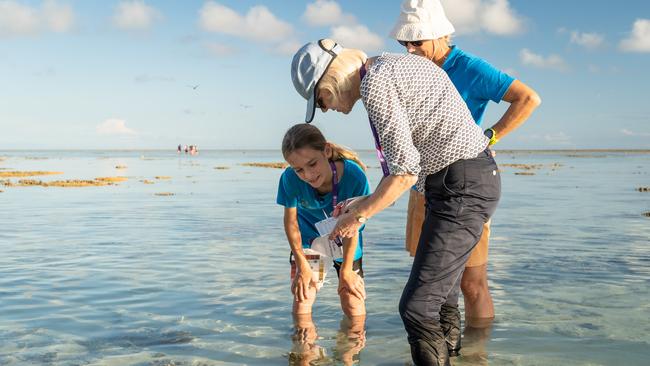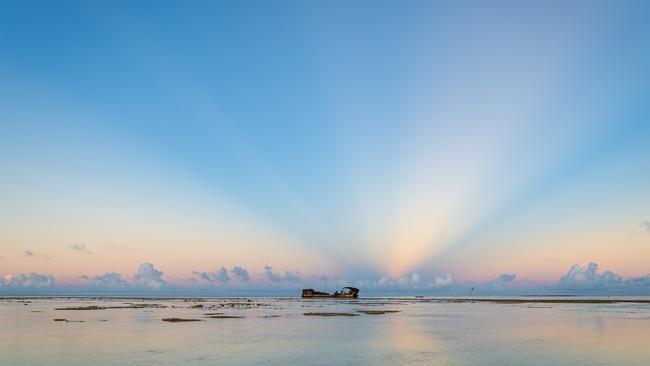‘Nature haven’: Idyllic Queensland spot photographed for NASA time capsule
This World Heritage-listed reef is so spectacular that scientists flock to UQ’s on-site research centre and NASA has amazingly sent a picture of it into space.

QWeekend
Don't miss out on the headlines from QWeekend. Followed categories will be added to My News.
About 23.8 billion kilometres from Earth, in interstellar space, there is an image of a pristine coral cay.
The image, one of 115 on board NASA’s Voyager I spacecraft as part of The Golden Record, is of Heron Island, an idyllic 16ha nature haven on the southern end of the Great Barrier Reef, 70km off Gladstone, on the central Queensland coast.
NASA’s time capsule of Earth – that also includes music, sounds and spoken greetings – is intended to portray the diversity of life for extraterrestrials that may find it.

A World Heritage-listed marine national park, Heron Island, 800m long and 300m wide, is part of the 13 islands of the Capricorn Bunker Group and a sanctuary for an abundance of marine species, including endangered green and loggerhead sea turtles, and an incredible array of birdlife like the buff banded rail, brown-footed booby, black noddy tern, bridal tern, silver-eyed finch, sea eagle and heron. (The island was named for the heron but it turns out the birds were, in fact, eastern reef egrets. Herons are a much rarer sight.)
By night, the island is overtaken by the weird, mournful wailing of the wedge-tailed shearwater or mutton bird that makes its nest in underground burrows. Sailors of the past, spooked by the sound, called it the “ghost bird’’.
There are no snakes or mammals on the island, making it a safe haven for nesting turtles and birdlife, in stark contrast to the island’s horrifying history in the 1920s as the site of a turtle soup factory.
Heron Island also boasts dense and spectacular pisonia forests with tree branches laden with sticky seeds that often macabrely “capture’’ and kill the black noddies that nest in them.
On Indigenous Gooreng Gooreng, Gurang, Bailai and Taribelang Bunda sea country, Heron has been visited by acclaimed naturalist Sir David Attenborough, who filmed part of his 2015 Great Barrier Reef series there.
Famed undersea explorer and filmmaker Jacques Cousteau listed the island’s Heron Bommie dive site as one of the top 10 dive sites in the world.

Busy with wildlife and surrounded by clear turquoise waters, the island is undoubtedly beautiful. But it is also a sought-after location for local, interstate and international scientists and students who use The University of Queensland’s Heron Island Research Station, the oldest and largest marine research station on the Great Barrier Reef and, in fact, the largest research facility on a coral reef in the world.
Dr Stuart Kininmonth has been the research station’s manager for the past three years after first visiting the island as a 10 year old.
Speaking to Qweekend at the station, he says Heron Island’s marine environment was a “million miles away’’ from his childhood, raised on a 550ha sheep property near Bairnsdale, in Victoria’s East Gippsland.
Kininmonth, 58, who has a doctorate in complex coral reef ecology, also has worked in Fiji, Sweden, Norway, Africa, Chile and Kakadu National Park in the Northern Territory. He stays 10 days at a time on Heron Island and four days at his home at the coastal town of Agnes Water, 120km north of Bundaberg.
He says the island’s research station is unique in terms of its location, just 100m to the reef, making it one of only a couple of places in the world where scientists can stay virtually on a coral reef.

The island also has a few other natural advantages – it is far enough off the coast to be away from the polluting effects of river run-off and sediment, and its southerly position generally protects it from cyclones (although not always).
Researchers come to Heron from the CSIRO and universities all over Australia and internationally – including the US, UK, Germany and France – for its unrivalled facilities and access to the reef and it’s common for the research station to be fully booked.
Research topics are broad – from bird and turtle migration, potential drugs from cone shell venom, and how a reef can reform after storm damage, to how artificial cloud generation might shield the reef from the effects of climate change.
“The Great Barrier Reef is by far the most studied system in the world and I think it would be easy to say Heron Reef is the most studied reef,’’ Kininmonth says.
“The topics studied here are enormous. We get to see so many different aspects of science.’’
Kininmonth says the seeds of the research station date back to the 1930s with “a few tents and sheds” when “it was just the old days of people doing their thing” before it was officially built in 1951.
In 1970, The University of Queensland became the station’s “operational partner” and took ownership of it in 1980. UQ also has a marine research station on Stradbroke Island.
In 2007, a substantial fire destroyed most of the research station. It was, Kininmonth says, “a complete blessing”.

A $9m rebuild saw the station reopen in 2009, bigger and better with cyclone-rated buildings, modern architecture and accessibility, above-ground buildings to accommodate bird habitats, a new education wing, student and researcher accommodation (for up to 140 people), eight laboratories with modern scientific equipment, a 4m x 4m shark pool and outdoor aquarium decks.
“The rebuild completely changed everything,” Kininmonth says.
“It made us big but also very effective. Everything works. We are the envy of many stations because they are still running with older designs.”
And while you would “never attempt such a thing nowadays”, Kininmonth says a harbour blasted out of the reef with dynamite in the 1940s means research can be conducted at any time, regardless of tides.
“You would never do it now but it is actually fantastic for us in terms of access. Most other places don’t have that luxury,” he says.
“We now have a very well-equipped facility with eight purpose-built laboratories, fully serviced with the latest scientific gear.
“It means people can do elaborate experiments within the confines of the station.”

In March, The University of Queensland’s vice chancellor Deborah Terry made her first visit to Heron Island and to the research station as part of a Regional Roadshow – an event bringing together alumni, UQ staff and researchers to engage with regional communities.
The roadshows are an initiative of Terry and the Heron Island trip was the first multi-day roadshow event. About 100 alumni stayed on the island for two nights – either in the island’s resort accommodation or in the research station itself.
“I’ve been to the vast majority of UQ’s other sites (there are 21) but never before to Heron,” Terry says. “It is a unique research facility and it is critically important … it does incredibly important work through research for UQ but it also facilitates research for the majority of other Australian universities, CSIRO and international partners. It’s a really important part of UQ’s research ecosystem.
“Universities exist to do three things – we educate, research and enrich our communities.
“I’m committed to ensuring that UQ is not seen simply to be a university in Brisbane. It’s ensuring UQ is seen to be a university for the whole state.”
Heron Island is also home to the not-for-profit citizen science program, Coral Watch, that began on the cay in 2002 after a coral bleaching event.

Now in its 21st year, the program involves volunteers matching the coral colour and type on a simple coral health chart. It boasts a global database with information from 80 countries, from more than 15,000 surveys and 8000 members.
Coral Watch manager Diana Kleine, a former art teacher who has worked for the program for 15 years, says it is a simple scientific tool to increase understanding of coral reefs, bleaching events and climate change.
Kleine is married to the Heron Island Research Station academic director Associate Professor Chris Roelfsema and the couple first came to Heron Island in 1998 after moving to Australia from the Netherlands (via Jamaica, Indonesia and Malaysia).
“I just love the reef,” Kleine says.
“The biggest threat to reefs is climate change. We want to reduce the impact as much as we can and we put out lots of ideas of what you can do to help reefs from home. It doesn’t matter where you are, you can help.
“We think it is very important that people see the reef. People need to see and experience the beauty of a coral reef to be able to care about it.”

Based out of The University of Queensland’s Centre for Marine Science, Coral Watch also has an ambassador program and has so far trained 78 people “from all walks of life” in the role during a five-day workshop on Heron Island, using the research station.
Ambassadors range in age from 71 years to the youngest, Elijah Richardson, 10, of Bargara, near Bundaberg (who has been an ambassador since he was eight).
Elijah, who says Heron Island is one of his favourite places, is passionate about educating people on the importance of helping the Great Barrier Reef and has even helped convince American singer songwriter Billie Eilish to allow Coral Watch use of her 2016 hit single Ocean Eyes.
Elijah, who says David Attenborough is his biggest role model, has been on Coral Watch stalls at various festivals, he gives presentations to schoolchildren and is an ambassador for beach clean group Tangaroa Blue.
His future goals, unsurprisingly, are to be a nature documentary maker or an underwater photographer.

“I want to educate more people and help the reef and I think my whole life I will be monitoring coral with the coral health chart,” he says.
“I definitely want to keep helping the ocean.
“My advice is to get out there and learn what you can do to help the reef. If you know what you can do, then you might be able to do more.
“If you know better, you can do better.”
Shooting through interstellar space at about 60,000km per hour, NASA’s Voyager I, with its image of Heron Island on board, is now the farthest human-made object from Earth.
It’s an awfully long way for the extraterrestrials to travel. But for Queenslanders, this world-renowned piece of paradise is right on our doorstep.




